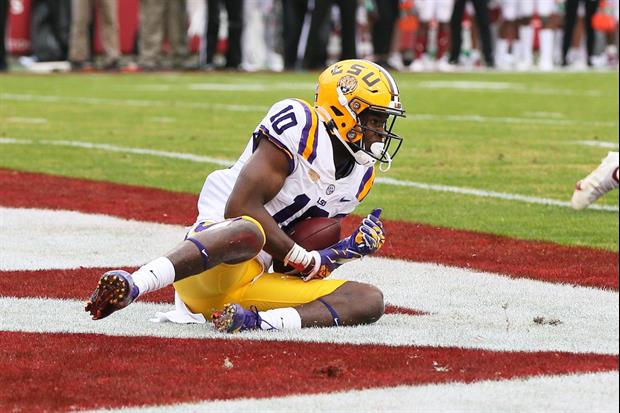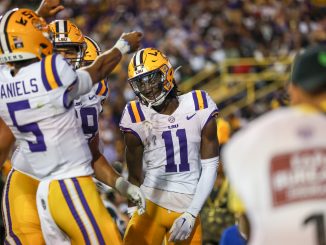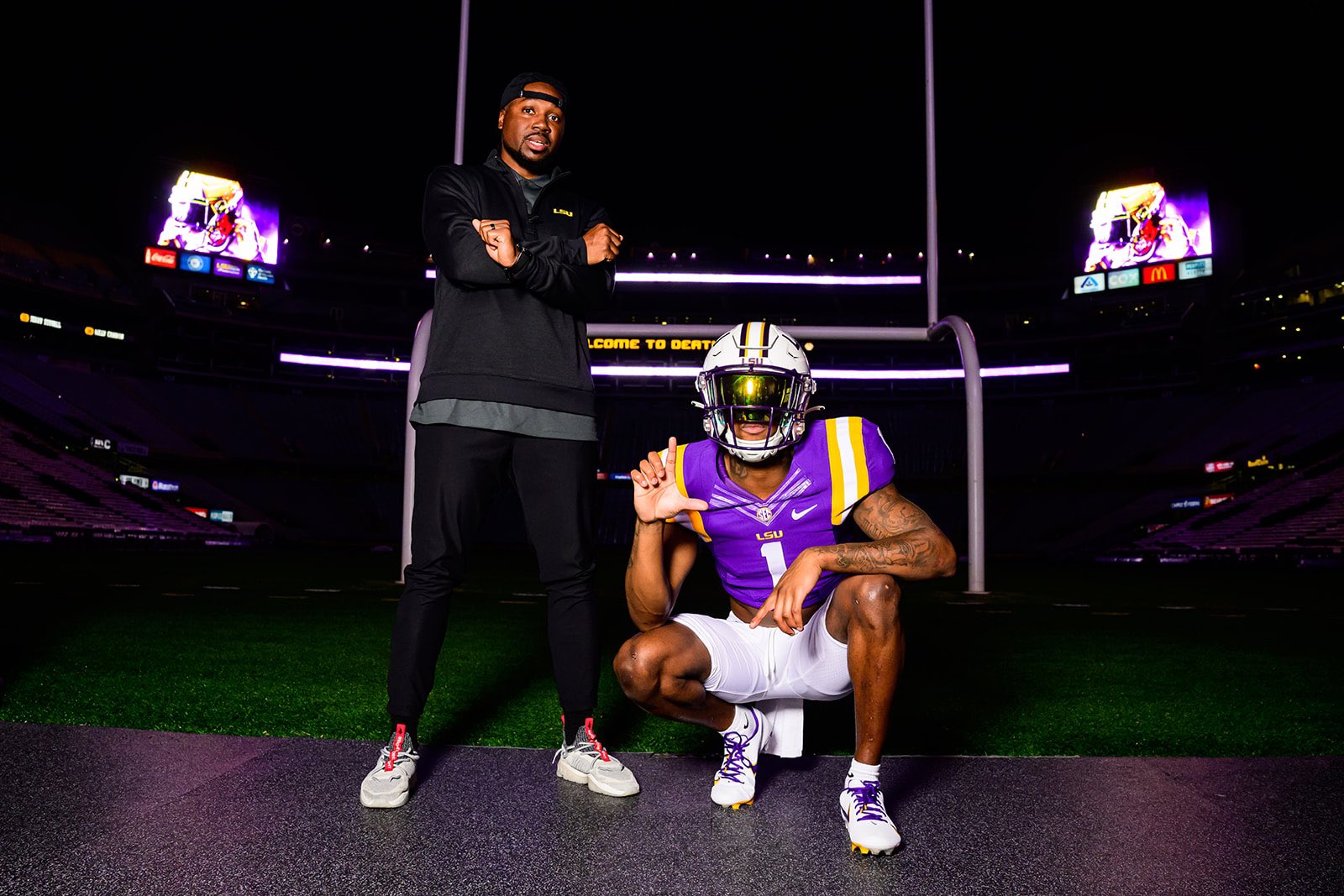
There was a lifetime of emotion balled into Jaray Jenkins’ first career touchdown reception, a game-winning 13-yard catch giving LSU a 27-24 victory at Arkansas last Saturday.
The moment took Jenkins back to his youth in tiny Jena, La. where he dreamed of such moments growing up in a community of approximately 4,000 residents in LaSalle Parish.
“As a kid, it was a dream to score a touchdown for the Tigers,” Jenkins said. “Whenever it happened, I was excited. We still had to fight for the game. It was a great team win.”
Jenkins’ well-timed touchdown enabled LSU to regain a three-point lead with 3:59 remaining. The Tigers were able to escape with a win when defensive back Jay Ward deflected a 44-yard game-tying Arkansas field goal attempt with 1:24 to play.
In what was a rather pedestrian game to that point, Jenkins finished with three catches for 43 yards. But he continued to build on a sophomore season, emerging into a consistent threat behind the team’s top two receivers Terrace Marshall Jr. and Arik Gilbert.
Jenkins has evolved into the Tigers third-leading receiver with 16 catches for 277 yards (17.3 yards per catch) and a touchdown.
“I’m so proud of Jaray,” LSU head football coach Ed Orgeron said. “His first year, he had to learn how to play football at the Division I level and he did. He kept on working and has turned into a team leader for us. He told me before the (Arkansas) game, ‘Hey coach, we’ve got this’ and he catches the game-winning pass. He’s a tremendous young man.”
When LSU All-American wide receiver Ja’Marr Chase decided in September to opt out of playing the 2020 season, LSU had several options to compensate for the 84 catches he had last season.
None included Jenkins, who redshirted in 2018 and caught five passes for 67 yards last season.
“I saw in the summer the media didn’t have my name in there,” Jenkins said. “So, I worked hard, and I knew that my time was coming, and I took advantage of it and I’m not looking back.”
Orgeron was a prominent source of touting the depth at wide behind Marshall. He expected players like seniors Racey McMath and Jontre’ Kirklin, along with highly touted freshmen such as Gilbert, Kayshon Boutte and Koy Moore.
“We didn’t name him but he’s a competitor,” Orgeron said. “It just goes to show you once you stay around in the program you develop, you’ll be able to play here.”
Jenkins was a three-star recruit out of Jena High where he caught 111 passes for 1,960 yards and 27 touchdowns, coupled with 448 yards rushing, Jena head coach Jay Roark played a prominent role in Jenkins’ development.
“In high school, I had coaches that pushed me,” Jenkins said. “I guess they saw in me that I was going to be great. They pushed me to be the best that I can. There were days where I didn’t want to go, I didn’t want to go hard at practice and they pushed me. They knew my ability. I’m thankful for everything they’ve done for me, pushing me forward and making me the man I am today.”
Jenkins arrived in the same signing class with Chase and Marshall and was redshirted and then played in seven games last season. He bided his time while both Chase and sophomore Justin Jefferson flourished playing with Heisman Trophy quarterback Joe Burrow. Marshall also enjoyed a solid season despite missing four games because of a foot injury.
Following a school-record 111 catches and 18 TDs, Jefferson declared for the NFL draft where he was ultimately selected with the 22nd overall choice by Minnesota Vikings. His departure created a void for this season’s LSU wide receiver corps to fill when the coronavirus pandemic hit in March.
That resulted in the cancellation of spring training after three practices. It began a disjointed approach to summer workouts because players weren’t permitted to return to campus until June when LSU embarked on the start of voluntary workouts for a season they weren’t certain would even take place.
Before the start of the season, which was pushed to Sept. 26, Chase opted out to begin his preparations for the 2021 NFL draft in whic he’s expected to be first-round selection.
That left LSU with a handful of still unproven options to step into Chase’s vacated spot to try and continue the success of the wide receiver corps.
“We knew who was coming back,” Jenkins said. “We knew Ja’Marr would be with us, but he had to make a decision. By him opting out it opened more windows for more guys. Like coach says, `It’s next man up.’ You have to keep the mentality of keeping that (wide receivers) room going and that’s what we’re doing. Trying to be the best that we can be.”
Jenkins believed he learned a lot by watching Jefferson and Chase, and felt prepared to step into their roles in LSU’s wide receiver-friendly offense.
“I learned from seeing the progress they made,” he said. “Just working with them, it boosted me up to where I wanted to be better than them. It just made me grind harder.”
Jenkins didn’t wait long to emerge and shed his anonymity this season, catching a career-high five passes for 85 yards in LSU’s season-opening 44-34 loss to Mississippi State. He subsequently had at least one catch in all of his team’s six games, highlighted by last week’s first trip to a college end zone.
With Arkansas dropping eight into coverage Jenkins broke off his route near the goal line as quarterback TJ Finley bought time by rolling to his right. Jenkins created enough separation to successfully haul in the go-ahead score on third-and-goal.
“I knew when I was going to get to my landmark there was going to be a tight window,” Jenkins said. “Then I saw TJ roll out, I looked around the field and saw an open spot and I just trusted in TJ that he would find me. He found me.
“It’s been a long time since I’ve been in the end zone. My first college one, it was crazy. It was hard to explain. I wish it was in Tiger Stadium, but it wasn’t. I knew my time was going to come. I knew I was going to get a touchdown. I just didn’t know when. I just knew it would be when my team needed me. We needed it in that moment and we made it happen.”




Be the first to comment